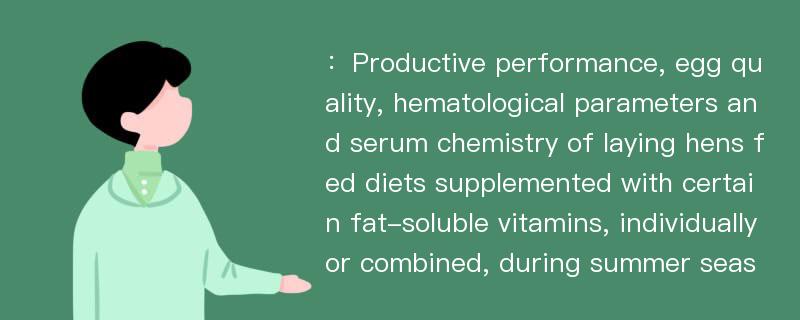
本文主要研究内容
作者(2019)在《Productive performance, egg quality, hematological parameters and serum chemistry of laying hens fed diets supplemented with certain fat-soluble vitamins, individually or combined, during summer season》一文中研究指出:This present study aimed to determine the efficacy of supplementing layer diets with vitamin A(0, 8,000 and16,000 IU/kg diet) and vitamin E(0, 250 and 500 mg/kg diet) either individually or in combination on egg production and quality, and blood hematology and chemistry of birds reared under summer conditions. A total of 135 Bovans Brown laying hens were distributed to 9 treatment groups with 5 replicates of 3 hens/pen in a 3 × 3 factorial design. A significant improvement in feed conversion ratio(FCR) was observed as supplementary vitamin A or E increased(P 0.01). Hens fed diets supplemented with 16,000 IU vitamin A plus 500 mg vitamin E/kg diet had the best FCR among all groups. Egg quality traits were not significantly affected by the interaction of vitamin A and vitamin E levels. There was a significant increase in monocytes(P ≤ 0.01)and a decrease in basophils counts(P ≤ 0.05) in response to vitamin E. Significant decreases were observed in packed cell volume(PCV), thyroxine(T4), alanine transferase(ALT), albumin, total cholesterol and total lipids((P ≤ 0.05 or P ≤ 0.01) P 0.01), and increases were observed in serum concentrations of globulin(P ≤ 0.05)and calcium(P ≤ 0.01) due to vitamin A. The combination of 0 IU vitamin A and 500 mg vitamin E/kg diet had the highest values of PCV(40.09%) and hemoglobin(Hb)(10.33 mg/100 mL) among all groups. Vitamin E raised serum values of total protein, total cholesterol and total lipids(P ≤ 0.05 or P≤ 0.01). Feed intake, FCR,PCV, Hb, lymphocytes, monocytes, eosinophils, T4, ALT and total protein were significantly affected by the interaction of vitamins A and E(P ≤ 0.05 or P ≤ 0.01). The interaction of vitamins A and E was only significant with respect to serum total protein(P ≤ 0.05). It can be concluded that layer diets supplemented with vitamins A and E had good results in alleviating the harmful impacts of high ambient temperature. The combination of 16,000 IU vitamin A and 500 mg vitamin E per kilogram diet is preferable for obtaining better production of laying hens reared under hot summer conditions.
Abstract
This present study aimed to determine the efficacy of supplementing layer diets with vitamin A(0, 8,000 and16,000 IU/kg diet) and vitamin E(0, 250 and 500 mg/kg diet) either individually or in combination on egg production and quality, and blood hematology and chemistry of birds reared under summer conditions. A total of 135 Bovans Brown laying hens were distributed to 9 treatment groups with 5 replicates of 3 hens/pen in a 3 × 3 factorial design. A significant improvement in feed conversion ratio(FCR) was observed as supplementary vitamin A or E increased(P 0.01). Hens fed diets supplemented with 16,000 IU vitamin A plus 500 mg vitamin E/kg diet had the best FCR among all groups. Egg quality traits were not significantly affected by the interaction of vitamin A and vitamin E levels. There was a significant increase in monocytes(P ≤ 0.01)and a decrease in basophils counts(P ≤ 0.05) in response to vitamin E. Significant decreases were observed in packed cell volume(PCV), thyroxine(T4), alanine transferase(ALT), albumin, total cholesterol and total lipids((P ≤ 0.05 or P ≤ 0.01) P 0.01), and increases were observed in serum concentrations of globulin(P ≤ 0.05)and calcium(P ≤ 0.01) due to vitamin A. The combination of 0 IU vitamin A and 500 mg vitamin E/kg diet had the highest values of PCV(40.09%) and hemoglobin(Hb)(10.33 mg/100 mL) among all groups. Vitamin E raised serum values of total protein, total cholesterol and total lipids(P ≤ 0.05 or P≤ 0.01). Feed intake, FCR,PCV, Hb, lymphocytes, monocytes, eosinophils, T4, ALT and total protein were significantly affected by the interaction of vitamins A and E(P ≤ 0.05 or P ≤ 0.01). The interaction of vitamins A and E was only significant with respect to serum total protein(P ≤ 0.05). It can be concluded that layer diets supplemented with vitamins A and E had good results in alleviating the harmful impacts of high ambient temperature. The combination of 16,000 IU vitamin A and 500 mg vitamin E per kilogram diet is preferable for obtaining better production of laying hens reared under hot summer conditions.
论文参考文献
论文详细介绍
论文作者分别是来自Animal Nutrition的,发表于刊物Animal Nutrition2019年01期论文,是一篇关于,Animal Nutrition2019年01期论文的文章。本文可供学术参考使用,各位学者可以免费参考阅读下载,文章观点不代表本站观点,资料来自Animal Nutrition2019年01期论文网站,若本站收录的文献无意侵犯了您的著作版权,请联系我们删除。
